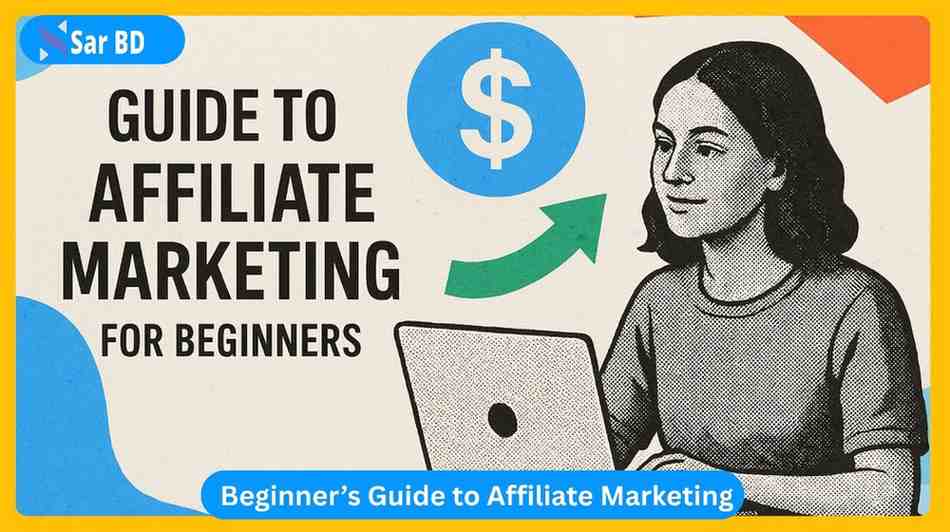Beginner’s Guide to Affiliate Marketing
Affiliate marketing is one of the most accessible and rewarding ways to earn passive income online. Whether you’re a blogger, content creator, YouTuber, or simply looking for a side hustle, the potential of affiliate marketing is undeniable. In this beginner’s guide to affiliate marketing, we will walk you through everything you need to know to get started and succeed in the long run.
What is Affiliate Marketing? Beginner’s Guide to Affiliate Marketing
In simple terms, affiliate marketing is a performance-based marketing strategy where an individual promotes another company’s products or services and earns a commission for every sale or lead generated through their referral link.
- You promote products or services using unique affiliate links. These links track any sales or signups generated through your traffic. Once a visitor purchases a product using your link, you earn a pre-agreed percentage or fixed amount. This model benefits both the company (more sales) and you (passive income).
- No need to create your own product or manage inventory. Unlike traditional business models, you don’t need to invest in product development, inventory, shipping, or customer support. You simply focus on recommending valuable products.
- Many niches and companies offer affiliate programs. From software tools and web hosting to fashion and fitness gear, affiliate opportunities exist across countless industries, making it easier to find something that aligns with your interests.
Why Start Affiliate Marketing?
If you’re exploring ways to make money online, this beginner’s guide to affiliate marketing will show why it’s worth considering.
- Low startup costs and low risk. All you need is a laptop, internet connection, and a platform to share your content (e.g., website, YouTube, or social media). Unlike traditional businesses, affiliate marketing requires no big financial investment.
- Scalable income potential. With consistent effort, your affiliate content can generate income on autopilot. As your audience grows, so does your potential to earn more.
- Flexibility and location independence. You can work from anywhere in the world, at your own pace. This makes affiliate marketing ideal for digital nomads, stay-at-home parents, or anyone seeking freedom in their work life.
- Great for beginners and seasoned marketers alike. Whether you’re new to digital marketing or a pro, affiliate marketing is a great entry point or an additional revenue stream.
How Does Affiliate Marketing Work?
Understanding the mechanics of affiliate marketing is essential. Here’s a closer look in this beginner’s guide to affiliate marketing.
- Join an affiliate program. Start by signing up for an affiliate program that matches your niche. Popular networks include Amazon Associates, ShareASale, CJ Affiliate, and individual company programs like Bluehost or Elementor.
- Receive a unique tracking link. Once approved, you’ll receive a unique affiliate link that tracks visitors and purchases coming from your content. This ensures you get credit for any sales you drive.
- Promote your affiliate links through content. Use blog posts, videos, email marketing, or social media to educate your audience about the product and provide your affiliate link.
- Earn commission for each qualifying action. When someone clicks your affiliate link and completes a purchase (or another required action), you earn a commission.
Choosing a Niche: First Step in the Beginner’s Guide to Affiliate Marketing
Your niche is the foundation of your affiliate business. Picking the right one is crucial.
- Choose a niche you are passionate about. Passion keeps you motivated, especially in the early stages when growth is slow. It’s easier to create content and connect with your audience when you genuinely care about the subject.
- Evaluate the earning potential. Not all niches are equally profitable. Some have high ticket items (like software or financial products), while others may have lower commissions but higher volume.
- Assess competition and demand. A highly competitive niche may be harder to break into, but it usually means there’s money to be made. Use keyword tools to analyze search volume and content gaps.
- Make sure affiliate products are available. Check if reliable affiliate programs exist within your niche. Having a wide range of products to promote gives you flexibility.
Building a Platform to Promote Affiliate Links
An essential step in this beginner’s guide to affiliate marketing is establishing your online presence.
- Create a blog or website. A self-hosted WordPress site gives you full control and is SEO-friendly. You can publish reviews, tutorials, comparisons, and more.
- Start a YouTube channel. Video content can be highly persuasive. Product demos and reviews are excellent for driving affiliate sales.
- Leverage social media platforms. Instagram, TikTok, Pinterest, Facebook, and Twitter can all be used to share valuable content and attract an audience.
- Build an email list. Email marketing allows you to directly communicate with your audience. It’s a powerful tool for promoting affiliate offers and increasing conversions.
Creating High-Converting Affiliate Content
Content is king in affiliate marketing. This section of the beginner’s guide to affiliate marketing focuses on crafting compelling content.
- Write product reviews and comparisons. Help users make informed decisions by offering pros, cons, and honest opinions. Include your personal experience and provide clear calls to action.
- Create tutorials and how-to guides. Step-by-step guides that solve problems can effectively promote affiliate products. For example, a tutorial on “How to Build a Website” can naturally include affiliate links to hosting services.
- Use listicles and roundup posts. Posts like “Top 10 Tools for Freelancers” can include multiple affiliate links and are great for SEO and user engagement.
- Optimize for SEO. Use keyword-rich titles, meta descriptions, and internal links to boost visibility. SEO helps drive organic traffic, which is crucial for long-term success.
Understanding Affiliate Commission Models
This beginner’s guide to affiliate marketing wouldn’t be complete without understanding how you get paid.
- Pay-per-sale (PPS). You earn a commission every time someone makes a purchase using your affiliate link. This is the most common model.
- Pay-per-lead (PPL). You earn when someone takes a specific action, like signing up for a free trial, newsletter, or demo.
- Pay-per-click (PPC). Less common in affiliate marketing, but you earn a small fee whenever someone clicks on your affiliate link, regardless of a purchase.
- Recurring commissions. Some programs pay you every month for as long as the customer stays subscribed. These are great for building consistent income.
Common Mistakes Beginners Make in Affiliate Marketing
Avoiding these pitfalls can save you time and frustration as you start your journey.
- Promoting too many products at once. It’s tempting to flood your content with affiliate links, but this dilutes your message and reduces trust. Focus on a few quality products.
- Ignoring the audience’s needs. Always prioritize helping your audience. Promote products that genuinely solve their problems.
- Not disclosing affiliate relationships. Transparency builds trust. Always disclose when a link is an affiliate link as per FTC guidelines.
- Expecting quick results. Affiliate marketing is a long-term strategy. It can take months to build traffic and generate consistent income.
Tracking and Optimizing Performance
As part of the beginner’s guide to affiliate marketing, you need to monitor what works and what doesn’t.
- Use analytics tools. Google Analytics, affiliate dashboards, and URL shorteners with tracking (like Bitly) help analyze click-through rates and conversions.
- Test different content formats. Videos may perform better than blogs for certain products. Experiment and stick with what converts best.
- A/B test your CTAs. Try different call-to-action styles and placements to improve conversions.
- Regularly update old content. Refreshing outdated reviews or blog posts ensures accuracy and improves SEO rankings.
FAQs: Beginner’s Guide to Affiliate Marketing
Q1: How much can I earn with affiliate marketing? A: Earnings vary widely based on niche, traffic, and effort. Beginners may earn a few dollars a month, while top affiliates make six to seven figures annually.
Q2: Do I need a website to start affiliate marketing? A: No, but having a website improves credibility and SEO. You can also start with social media or YouTube.
Q3: Is affiliate marketing legit or a scam? A: Affiliate marketing is 100% legit. It’s used by major brands like Amazon, eBay, and Apple to drive sales.
Q4: How do I find good affiliate programs? A: Research your niche, join affiliate networks, and check product websites for affiliate links.
Q5: Can I do affiliate marketing without spending money? A: Yes, you can start with free tools like WordPress.com or social media, though investing in your website and tools can speed up growth.
Final Thoughts: Beginner’s Guide to Affiliate Marketing
Affiliate marketing is one of the most practical and scalable ways to earn online income. This beginner’s guide to affiliate marketing has outlined the essential steps, from choosing a niche and building a platform to creating content and tracking performance.
Start slow, focus on value, and be consistent. Success won’t happen overnight, but with persistence, the rewards can be life-changing.
Ready to begin your journey? Choose your niche, sign up for an affiliate program, and start creating valuable content today. The world of affiliate marketing is waiting for you!


